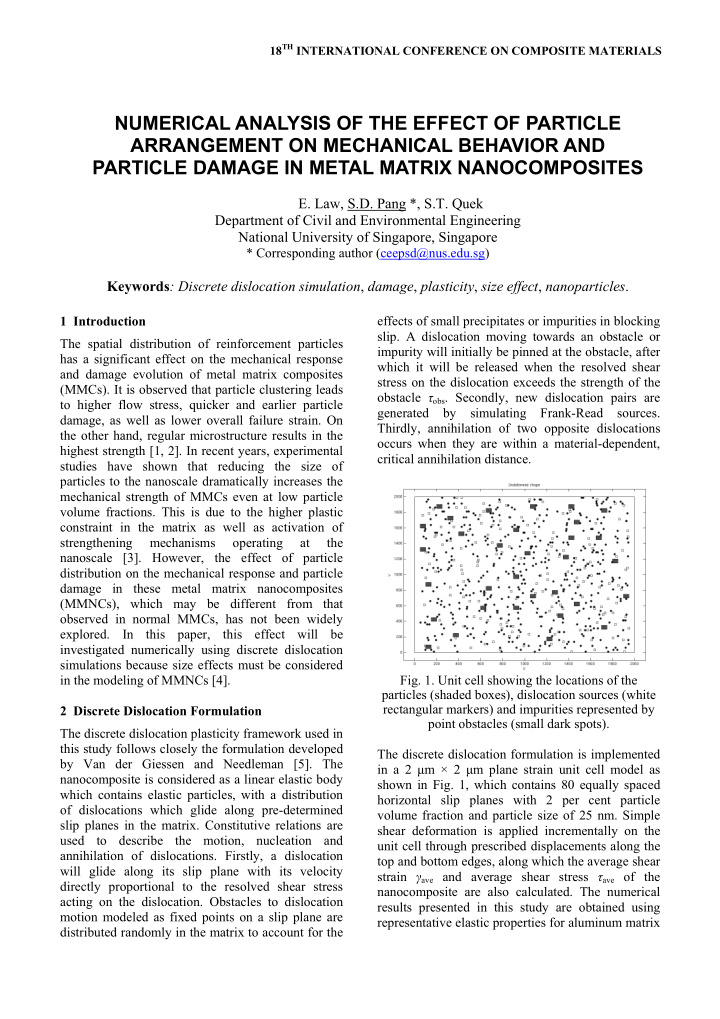



18 TH INTERNATIONAL CONFERENCE ON COMPOSITE MATERIALS NUMERICAL ANALYSIS OF THE EFFECT OF PARTICLE ARRANGEMENT ON MECHANICAL BEHAVIOR AND PARTICLE DAMAGE IN METAL MATRIX NANOCOMPOSITES E. Law, S.D. Pang *, S.T. Quek Department of Civil and Environmental Engineering National University of Singapore, Singapore * Corresponding author (ceepsd@nus.edu.sg) Keywords : Discrete dislocation simulation , damage , plasticity , size effect , nanoparticles . 1 Introduction effects of small precipitates or impurities in blocking slip. A dislocation moving towards an obstacle or The spatial distribution of reinforcement particles impurity will initially be pinned at the obstacle, after has a significant effect on the mechanical response which it will be released when the resolved shear and damage evolution of metal matrix composites stress on the dislocation exceeds the strength of the (MMCs). It is observed that particle clustering leads obstacle τ obs . Secondly, new dislocation pairs are to higher flow stress, quicker and earlier particle generated by simulating Frank-Read sources. damage, as well as lower overall failure strain. On Thirdly, annihilation of two opposite dislocations the other hand, regular microstructure results in the occurs when they are within a material-dependent, highest strength [1, 2]. In recent years, experimental critical annihilation distance. studies have shown that reducing the size of particles to the nanoscale dramatically increases the mechanical strength of MMCs even at low particle volume fractions. This is due to the higher plastic constraint in the matrix as well as activation of strengthening mechanisms operating at the nanoscale [3]. However, the effect of particle distribution on the mechanical response and particle damage in these metal matrix nanocomposites (MMNCs), which may be different from that observed in normal MMCs, has not been widely explored. In this paper, this effect will be investigated numerically using discrete dislocation simulations because size effects must be considered in the modeling of MMNCs [4]. Fig. 1. Unit cell showing the locations of the particles (shaded boxes), dislocation sources (white rectangular markers) and impurities represented by 2 Discrete Dislocation Formulation point obstacles (small dark spots). The discrete dislocation plasticity framework used in this study follows closely the formulation developed The discrete dislocation formulation is implemented by Van der Giessen and Needleman [5]. The in a 2 μ m × 2 μ m plane strain unit cell model as nanocomposite is considered as a linear elastic body shown in Fig. 1, which contains 80 equally spaced which contains elastic particles, with a distribution horizontal slip planes with 2 per cent particle of dislocations which glide along pre-determined volume fraction and particle size of 25 nm. Simple slip planes in the matrix. Constitutive relations are shear deformation is applied incrementally on the used to describe the motion, nucleation and unit cell through prescribed displacements along the annihilation of dislocations. Firstly, a dislocation top and bottom edges, along which the average shear will glide along its slip plane with its velocity strain γ ave and average shear stress τ ave of the directly proportional to the resolved shear stress nanocomposite are also calculated. The numerical acting on the dislocation. Obstacles to dislocation results presented in this study are obtained using motion modeled as fixed points on a slip plane are representative elastic properties for aluminum matrix distributed randomly in the matrix to account for the
and silicon carbide reinforcement nanoparticles; these material properties and various parameters used to describe dislocation processes in the constitutive relations follow that in Law et al. [6]. The mean overall response is computed using many different realizations of dislocation source, impurities and particle distributions since the overall response is highly dependent on these distributions. (a) 3 Effect of Particle Arrangement on Overall Response of MMNCs with Undamaged Particles Fig. 2 shows that regular rectangular and non- clustered random particle arrangements result in the lowest and highest flow stress, respectively. This is because the number of slip planes blocked by the particles is minimized for the rectangular arrangement and there are many large veins of unreinforced matrix as shown in Fig. 3(a). Dislocations can move relatively easily with little hindrance on the many unobstructed slip planes. On (b) the other hand, most slip planes are blocked by particles when the arrangement is well-dispersed as shown in Fig. 3(b). Dislocations unable to bypass the particles will form many dislocation pile-ups, which retard the generation of new dislocations and hinder the motion of existing dislocations. Impediment to dislocation motion increases the flow stress of the metallic nanocomposite. Fig. 2 also shows that a highly clustered particle arrangement (the degree of clustering is measured using the nearest-neighbor index (NNI), with smaller NNI indicating greater degree of clustering) produces (c) lower flow stress compared to non-clustered random arrangement because there are more unobstructed slip planes in the matrix, as shown in Fig. 3(c). On the other hand, a mildly clustered particle arrangement only results in minor reduction in the flow stress since most slip planes are still blocked by the particles as shown in Fig. 3(d). 50 Mean response Average shear stress, τ ave (MPa) 45 τ particle = 1000 MPa 40 35 (d) 30 25 Rectangular - NNI = 0.963 20 Random - NNI = 0.773 Fig. 3. Distribution of dislocations (+ and ×) and 15 Mildly clustered - NNI = 0.581 10 particles (shaded boxes) at γ ave = 1.05% for (a) Highly clustered - NNI = 0.308 5 0% particle regular rectangular, (b) non-clustered random, (c) γ ave (%) 0 highly clustered (NNI = 0.308), and (d) mildly 0.0 0.1 0.2 0.3 0.4 0.5 0.6 0.7 0.8 0.9 1.0 1.1 Fig. 2. Mean overall response of MMNC with clustered (NNI = 0.581) particle arrangements. undamaged particles for different particle arrangements.
Recommend
More recommend